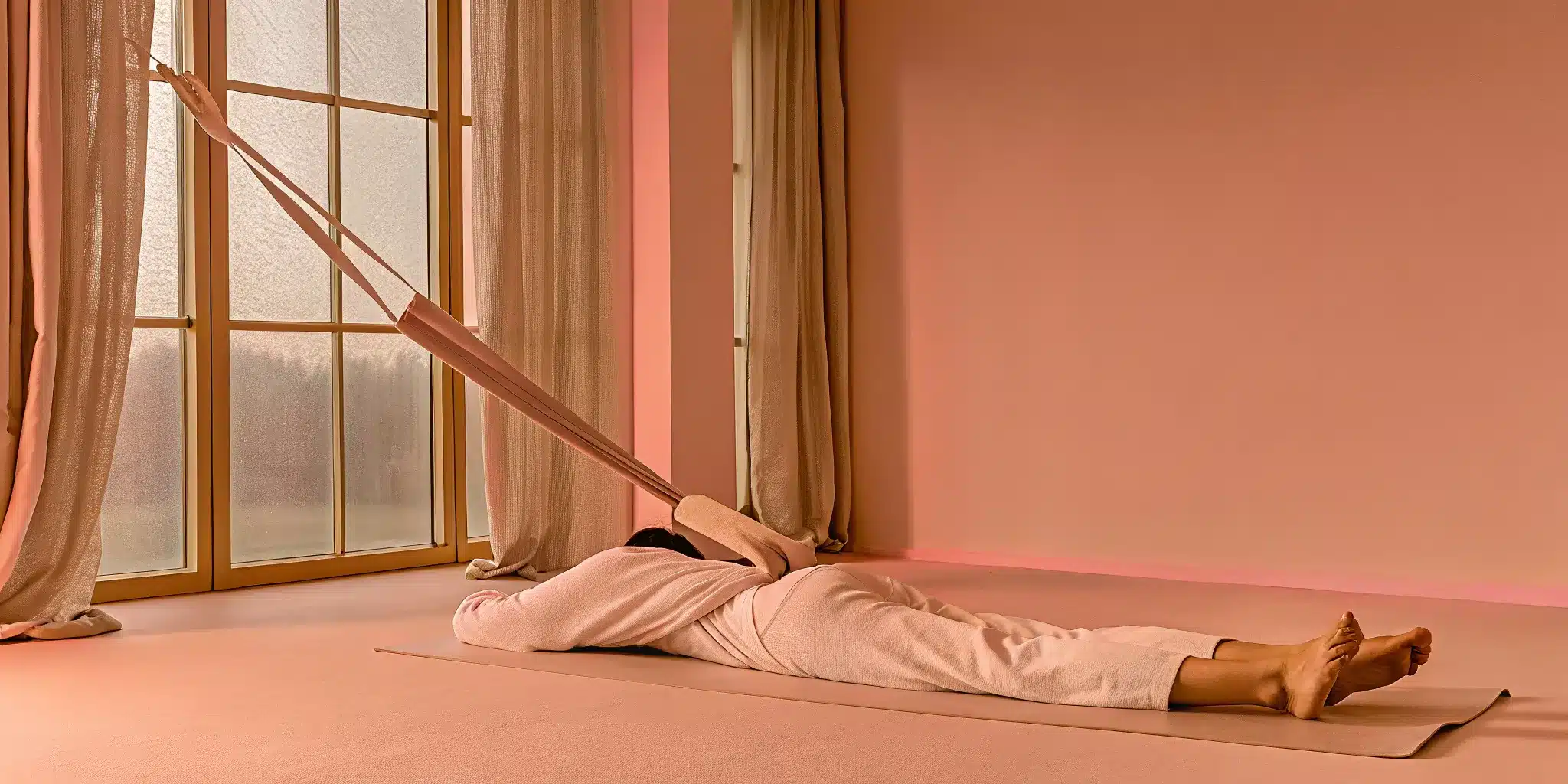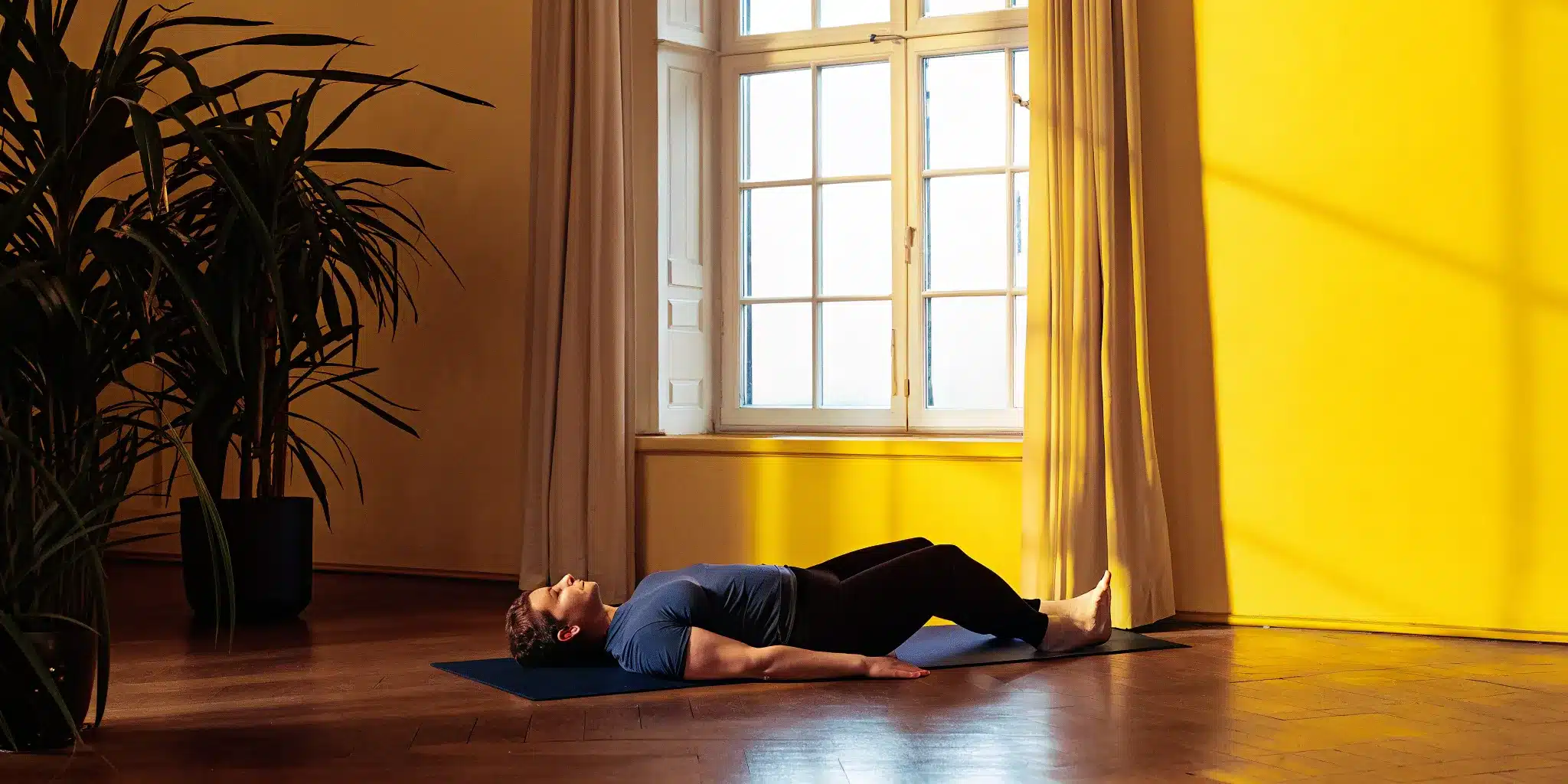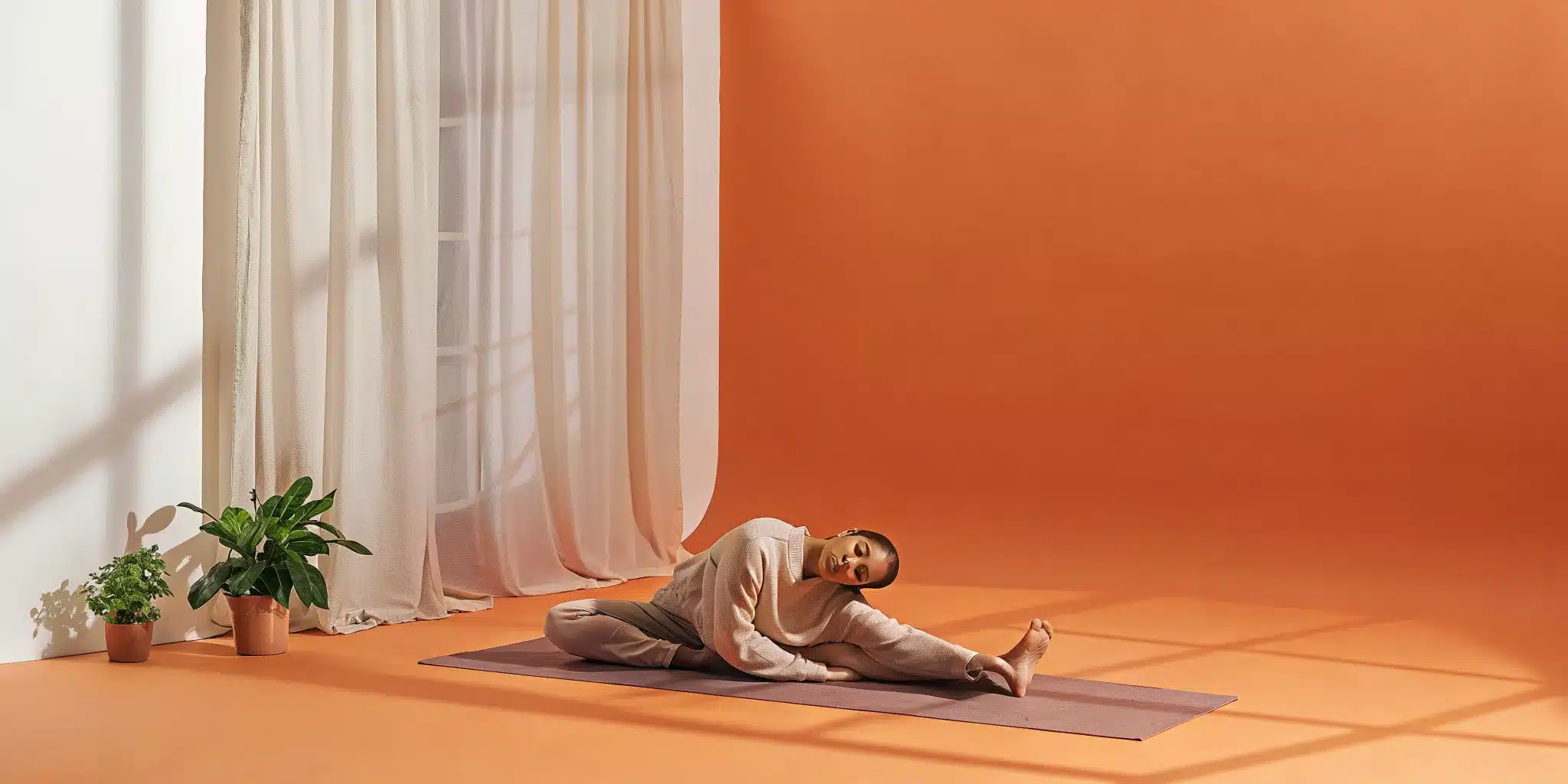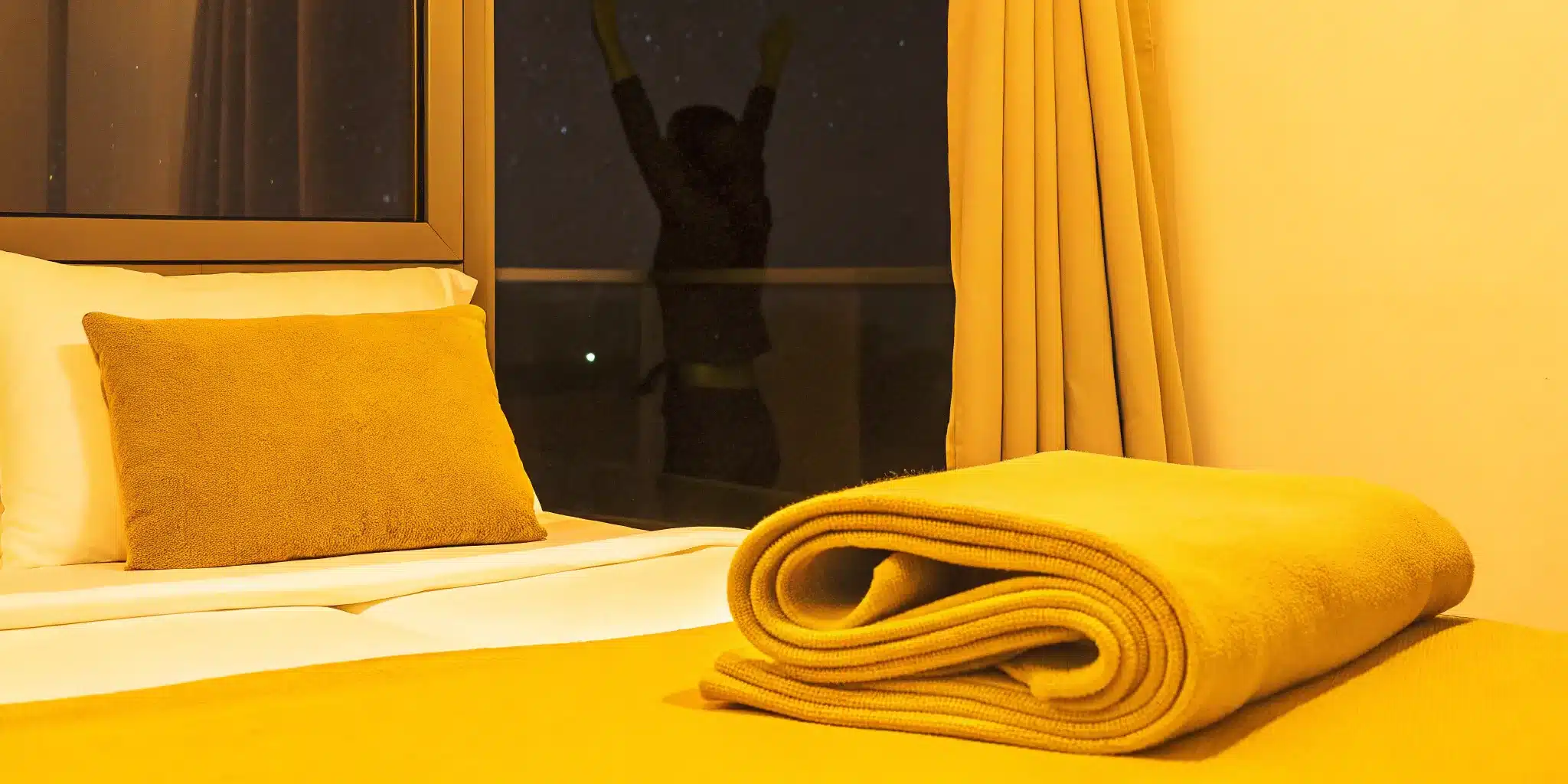Have you ever tried to push open a door that’s locked? You can push with all your might, but it won’t budge. Traditional stretching can sometimes feel like that—you’re pushing against a muscle that’s fighting back. PNF stretching is like finding the key. Instead of forcing the muscle, it works with your nervous system to unlock it from the inside. By alternating between contracting and relaxing a muscle, you send a signal to your brain that it’s safe to release tension. This is the core of what is PNF stretching—a smarter, more communicative approach to improving mobility. In this article, we’ll explore the science behind it, the different techniques, and how it can help you move with more freedom and less pain.
Key Takeaways
- Work with your body’s reflexes: PNF uses a contract-and-relax sequence to tap into your nervous system, which tells your muscles it’s safe to release tension and achieve a deeper, more effective stretch.
- Build functional mobility, not just flexibility: Beyond just lengthening muscles, PNF helps you build usable strength, find lasting relief from chronic aches, and improve your body’s overall resilience to injury in your daily life.
- Partner with a pro for the best results: Because PNF is an advanced technique, it’s safest and most effective when performed with a trained practitioner who can apply the correct resistance and guide you through the movements without risk of injury.
What Exactly Is PNF Stretching?
If you’ve ever felt like you’ve hit a plateau with your flexibility, PNF stretching might be the breakthrough you’re looking for. PNF stands for Proprioceptive Neuromuscular Facilitation, which is a technical way of saying it’s a stretching technique that uses your body’s own reflexes to deepen the stretch. It involves a combination of passive stretching and muscle contraction to help you achieve a greater range of motion. Originally developed to help people with neurological conditions, it’s now a go-to method for physical therapists, athletes, and anyone looking to improve their mobility and find relief from muscle tightness.
The Simple Science of How It Works
So, how does PNF help you stretch deeper than you could on your own? It all comes down to a clever conversation between your muscles and your nervous system. When you stretch a muscle to its limit and then contract it, you activate tiny sensory receptors within the muscle and tendon. These receptors send a signal to your brain that essentially tells the muscle it’s safe to relax. This process temporarily overrides the natural stretch reflex that normally stops you from pushing too far. The result is a brief window where your muscle can lengthen more than it usually would, allowing for a more effective and lasting stretch.
Where Did PNF Come From?
PNF stretching has a rich history rooted in clinical rehabilitation. It was first developed in the 1940s by Dr. Herman Kabat as a way to treat patients with neuromuscular conditions like polio and multiple sclerosis. He discovered that by combining specific stretching patterns with resistance, he could help patients restore function and improve their movement. Over time, physical therapists and fitness professionals recognized its incredible benefits for a wider audience. Today, it’s used everywhere from physical therapy clinics to professional sports training rooms to help people recover from injuries and enhance physical performance.
The Core Principles of PNF
At its heart, PNF is all about improving both flexibility and your functional range of motion—how far you can move your joints in different directions. Unlike a simple static stretch where you just hold a position, PNF is an active process. It requires you to consciously contract and relax specific muscles against resistance, often with the help of a partner or a professional. This active engagement is what makes it so effective. By working with your body’s neuromuscular system instead of just pulling against it, PNF helps retrain your muscles to relax more fully and accept a new, greater range of movement.
How PNF Stretching Changes Your Body
If you’ve ever felt like you’ve hit a wall with your flexibility, PNF stretching might feel like finding a secret door. It’s more than just pulling on a muscle and hoping for the best. PNF is a dynamic conversation between your brain, your nervous system, and your muscles. It works by tapping into your body’s natural reflexes to gently coax muscles into a deeper, more lasting state of release. Instead of fighting against your body’s protective instincts, PNF works with them.
This unique approach is what makes it so effective for improving range of motion and easing the chronic tightness that contributes to pain. By alternating between stretching and contracting a muscle, you’re essentially resetting its comfort zone. Your brain learns that a greater range of motion is safe, allowing the muscle to relax and lengthen in a way that simple static stretching often can’t achieve. It’s a smarter, more communicative way to stretch, leading to real, functional changes in how your body moves and feels. This is why it can be a game-changer for anyone dealing with persistent stiffness or looking to regain mobility after being sedentary.
Understanding the Stretch Reflex
Have you ever stretched a little too far and felt your muscle immediately tighten up? That’s your stretch reflex in action. It’s a built-in safety mechanism designed to protect your muscles from tearing. When your nervous system senses a muscle is being stretched too quickly or intensely, it sends a signal for that muscle to contract and resist the stretch. PNF uses a clever technique to work around this protective response. By having you actively contract the stretched muscle against resistance, you trigger a different reflex that tells the muscle it’s okay to relax more deeply once the contraction ends. This allows for a safer, more effective stretch.
The Brain-Muscle Connection
At its core, PNF stretching is all about improving the communication between your brain and your muscles. The process involves a combination of passive stretching and muscle contraction, which is why it’s so effective when performed with a trained practitioner. First, your muscle is gently eased into a stretch. Then, you’ll be guided to contract that same muscle against gentle pressure for a few seconds. This active engagement sends a powerful signal to your nervous system, essentially recalibrating what it perceives as a safe limit. When you relax again, your brain allows the muscle to lengthen further than it did before, creating a new, expanded range of motion.
How Your Body’s Sensors Help You Stretch
Your muscles and tendons are filled with tiny, intelligent sensors that help manage tension and movement. One key player in PNF stretching is the Golgi tendon organ (GTO). Think of the GTO as a tension-monitoring system. When you contract a muscle against resistance during a PNF stretch, the GTO senses this increase in tension and sends a message to your spinal cord. In response, your nervous system sends back a signal that tells the muscle to relax. This process, known as autogenic inhibition, is a natural protective mechanism that facilitates a deeper release and allows for a greater stretch than you could achieve on your own.
Three Core PNF Techniques to Try
Ready to see how PNF works in practice? While the names might sound a bit clinical, the movements themselves are quite intuitive. These techniques are built around a sequence of stretching, contracting, and relaxing your muscles to achieve a deeper release.
Because PNF involves active resistance, it’s most effective and safest when performed with a partner or a trained professional who can provide support and guide you through the motions. Let’s walk through the three most common PNF stretching techniques so you know what to expect during an assisted stretching session.
The Hold-Relax Technique
This is one of the most common PNF methods and a great starting point. It’s a simple, three-step process. First, your practitioner will gently move your limb to stretch a target muscle until you feel a light tension. You’ll hold this passive stretch for a few seconds. Next, you’ll contract that same muscle against their hand without actually moving—this is called an isometric contraction. After holding that contraction for about five to eight seconds, you relax. As you exhale, your practitioner will guide you into a deeper stretch, and you’ll immediately notice an increased range of motion.
The Contract-Relax Technique
The contract-relax method is very similar to hold-relax, but with one key difference. Instead of contracting the muscle without moving, you’ll contract it while moving through its range of motion against resistance. For example, if you’re stretching your hamstring, your practitioner would lift your leg. Then, you would actively push your leg back down against their gentle resistance. After the contraction, you relax, and they guide you into a new, deeper stretch. This technique is fantastic for targeting specific muscle groups and improving active flexibility, which helps you move better in your daily life.
The CRAC Technique
CRAC stands for Contract-Relax, Antagonist-Contract, and it’s a slightly more advanced method that really maximizes your gains. It starts just like the contract-relax technique: you stretch, you contract the target muscle against resistance, and then you relax. But here’s the extra step: to move deeper into the stretch, you actively engage the opposite muscle (the antagonist). So, for that hamstring stretch, after relaxing your hamstring, you would actively use your quadriceps (the antagonist muscle) to pull your leg further into the stretch. This sends a powerful signal to your nervous system to release the hamstring even more.
Don’t Forget to Breathe: Why It Matters
No matter which technique you’re using, your breath is your most powerful tool. It’s natural to hold your breath when you feel tension, but doing so actually causes your muscles to tighten up, working against your goal. Focusing on deep, steady breathing tells your nervous system that you’re safe, allowing your muscles to let go. Try to inhale as you prepare and exhale slowly as you move deeper into the stretch. This simple act of mindful breathing can make a world of difference in your results, helping you release tension and find more freedom in every movement.
Real-World Benefits of PNF Stretching
So, we’ve talked about the science behind PNF stretching, but what does it actually do for you? This is where it gets exciting. The benefits of PNF aren’t just theoretical; they show up in your daily life in very real ways. Think about the little things that have become difficult—bending over to tie your shoes, reaching for something on the top shelf, or even just getting out of bed without that familiar ache. PNF stretching is designed to address these exact challenges.
It’s more than just touching your toes. It’s about restoring your body’s natural ability to move with ease and confidence. By combining stretching with muscle contractions, PNF helps re-educate your neuromuscular system. This process leads to greater flexibility, functional strength, and a significant reduction in the chronic aches and pains that hold you back. It’s a proactive approach that not only helps you feel better now but also builds a more resilient body for the future. Let’s look at exactly how PNF can change the way you move through your world.
Improve Your Flexibility and Move Freely
If you feel like your body is fighting you on every movement, PNF can feel like a breakthrough. Its unique approach is incredibly effective at increasing your flexibility. By targeting specific muscle groups, PNF helps you gradually and safely expand your range of motion. This isn’t about forcing your body into uncomfortable positions. Instead, it’s a gentle conversation with your muscles, encouraging them to relax and lengthen. The result? Everyday movements become easier. You’ll notice more freedom in your hips when you walk, less tension in your shoulders when you sit at a desk, and an overall sense of ease that you may not have felt in years.
Build Functional Strength
When you hear “strength,” you might picture lifting heavy weights at the gym, but that’s not what we’re talking about here. PNF helps you build functional strength—the kind you use every single day. Because PNF stretching involves both stretching and contracting your muscles, it actively works to strengthen them. This means you’re not just making your muscles longer; you’re making them smarter and more capable. This added strength provides better support for your joints and improves your stability, making it easier to carry groceries, play with your kids, or get up from a low chair without a struggle. It’s about making your body work better for you in your real life.
Find Lasting Relief from Aches and Pains
For many of us, chronic pain is just a part of life we’ve learned to accept. But it doesn’t have to be. PNF stretching can be a powerful tool for finding lasting relief. Studies have shown it can help reduce chronic lower back pain by addressing the muscular imbalances that often cause it. When certain muscles are too tight and others are too weak, it throws your whole body out of alignment. PNF helps correct these issues by releasing tension and strengthening weak areas. This improves your body’s overall alignment and stability, taking pressure off your joints and easing the constant strain that leads to persistent aches and pains.
Protect Your Body from Future Injury
One of the most empowering benefits of PNF stretching is its ability to make your body more resilient. It’s often used in physical therapy and rehabilitation to restore muscle function and improve overall movement patterns. By increasing both flexibility and strength, PNF helps create muscles that are better prepared to handle physical stress. This means you’re less likely to suffer a strain when you reach for something suddenly or twist the wrong way. Better functional movement means your body can move more efficiently and safely, significantly reducing your risk of injury whether you’re playing a sport or just navigating your daily routine.
Is PNF Stretching Right for You?
PNF stretching is a powerful tool, but its intensity means it’s not a one-size-fits-all solution. The right stretching routine depends entirely on your body, your history, and your goals. Whether you’re a competitive athlete, recovering from an injury, or simply trying to move through your day with less pain, PNF could be a great fit. Let’s look at who can benefit most from this technique and when it’s best to proceed with caution.
For Athletes and Fitness Lovers
If you’re active and looking to improve your physical performance, PNF stretching is for you. This technique is a favorite among athletes for good reason. It’s a powerful way to increase your range of motion and build muscle strength in a way that static stretching alone can’t. By pushing your muscles to their limits in a controlled way, you can achieve deeper flexibility and more power. This can translate to a stronger golf swing, a higher kick, or a faster sprint. Incorporating PNF into your training can help you reach new levels of performance and keep your body resilient.
For Those Recovering from an Injury
Life after an injury can be frustrating, but PNF stretching can be a valuable part of your recovery plan. Under the guidance of a professional, this method is often used to help restore muscle extensibility and get your joints moving properly again. Because it actively engages the muscles, PNF helps re-establish the connection between your brain and your body, which is crucial for regaining function and confidence in your movements. It’s a targeted approach that can help you heal more effectively and get back to doing what you love with less risk of re-injury.
For Anyone Living with Chronic Pain
When you live with chronic pain, finding lasting relief is everything. PNF stretching can be a game-changer. By improving your flexibility, this technique helps ease the tension and stiffness that contribute to persistent aches. It can also significantly improve how much you can move your joints, making everyday activities like bending down or reaching overhead feel much easier. Over time, building this functional range of motion not only provides relief but also helps your body become more resilient, protecting you from future aches and pains. It’s a proactive way to manage discomfort and reclaim your freedom of movement.
When to Be Cautious with PNF
While PNF has incredible benefits, it’s an advanced technique that requires proper form to be safe and effective. This is not a stretch to try on your own for the first time. Because it involves contracting your muscles at their end range of motion, there is a risk of muscle tears if it’s done incorrectly. It’s always best to learn PNF from a qualified professional, like a physical therapist or a certified stretch practitioner. They can guide you through the movements safely, ensure you’re using the right amount of resistance, and tailor the stretches to your body’s specific needs.
How to Practice PNF Safely
PNF stretching is an incredibly effective way to improve your flexibility and reduce pain, but because it’s an advanced technique, it’s important to approach it with care. Doing it correctly means you’ll get all the amazing benefits without the risk of injury. Think of it like learning any new skill—you want to build a solid foundation first. Let’s walk through the best ways to practice PNF safely so you can feel confident and get the results you’re looking for.
Key Safety Tips to Remember
First things first: PNF stretching isn’t for total beginners. It’s a powerful technique, and it’s best to learn it from a physical therapist or a professional trainer who can show you the ropes. Always warm up your body before starting with five to ten minutes of light cardio, like walking or jogging in place. This gets blood flowing to your muscles, making them more pliable. Most importantly, listen to your body. A deep stretch should feel intense but never painful. If you feel any sharp or shooting pain, back off immediately.
Avoid These Common Stretching Mistakes
It’s easy to get excited and push a little too hard, but this is where injuries can happen. One of the biggest mistakes is forcing a stretch. You can overstretch or injure your muscles if you perform PNF incorrectly, which can set you back in your progress. Another thing to consider is timing. Some studies suggest that doing PNF right before an intense workout might temporarily reduce your strength or power. To be safe, it’s often best to save your PNF routine for after your workout or on a dedicated recovery day.
Why Professional Guidance Is a Game-Changer
If you’re new to PNF or are recovering from an injury, working with a trained professional is the safest and most effective way to practice. A certified stretch practitioner or physical therapist can ensure your form is perfect, apply just the right amount of resistance, and guide you into a stretch that’s tailored to your body’s specific needs. They take the guesswork out of the equation, helping you achieve a deeper, more effective stretch than you could on your own while keeping you safe from harm. This personalized attention is what helps you make real, lasting progress.
What Equipment Do You Need?
You don’t need a home gym to practice PNF, which is great news. Many of the most effective PNF stretches require a partner to help with the passive stretching and provide resistance during the contraction phase. This is why 1-on-1 assisted stretching is so beneficial. However, you can still do some PNF stretches on your own. For solo sessions, you can use a sturdy, non-elastic strap, a resistance band, or even a rolled-up towel to help you get similar results for muscles like your hamstrings and quads.
PNF vs. Other Types of Stretching
With so many ways to stretch, it’s easy to wonder which one is right for you. PNF stands out because of its unique, active approach. Unlike simply holding a stretch, PNF involves a sequence of contracting and relaxing your muscles to achieve a deeper release. This method essentially communicates with your nervous system, telling it that it’s safe to let go of tension. Let’s look at how PNF compares to the stretching techniques you might already know and when to use each one for the best results.
How It Differs from Static Stretching
You’re probably most familiar with static stretching—it’s the classic “reach and hold” method we all learned in gym class. You lengthen a muscle to the point of a gentle pull and hold it there for about 30 seconds. While static stretching is great for maintaining flexibility, PNF takes it a step further. PNF combines this passive hold with an active muscle contraction. By tensing the stretched muscle against resistance (like a partner’s hand), you trigger a relaxation response that allows for greater increases in flexibility than a static hold alone. It’s a more active process that can help you move past flexibility plateaus.
How It Differs from Dynamic Stretching
Dynamic stretching is all about movement. Think of exercises like arm circles, leg swings, or walking lunges. The goal here isn’t to hold a position but to warm up your muscles and joints by taking them through their full range of motion. It’s the perfect way to prepare your body for a workout. PNF, on the other hand, is designed to increase your resting level of flexibility and is best done when your muscles are already warm. The technique and guidelines for PNF focus on lengthening muscles for long-term gains, while dynamic stretching is about getting them ready for immediate action.
Which Stretch Is Best for Your Goals?
The best stretch really depends on what you want to achieve. If you’re about to go for a run or play a sport, dynamic stretching is your best friend for a warm-up. For a simple cool-down or to relieve a bit of daily tension, static stretching is a solid choice. But if your goal is to make significant, lasting improvements in your range of motion, reduce chronic stiffness, and even build functional strength, PNF is the most effective tool in the box. It’s particularly powerful for anyone feeling “stuck” in their flexibility progress or seeking relief from persistent tightness, making it a key to enhanced performance in both athletics and daily life.
The Best Time to Incorporate PNF
Timing is everything, especially with PNF. Because it creates such a deep release, it’s best performed when your muscles are already warm, like after a workout or as a dedicated flexibility session. This is when your muscles are most receptive to change. It’s important not to do PNF stretching right before a high-intensity activity like lifting heavy weights or sprinting. The deep relaxation it causes can temporarily reduce your muscle’s immediate power output. Instead, think of PNF as a restorative practice that has profound effects on range of motion when used for recovery and mobility improvement.
Add PNF to Your Weekly Routine
Ready to make PNF stretching a regular part of your life? The key is to start smart and stay consistent. You don’t need to overhaul your entire schedule overnight. Instead, think of PNF as a powerful tool you can weave into your existing routine to help you move better and feel your best. Whether you’re looking to ease chronic tightness or improve your athletic performance, adding just a couple of dedicated PNF sessions each week can make a significant difference.
The goal is to create a sustainable habit that your body will thank you for. It’s about listening to your body’s signals, celebrating small wins, and gradually building a practice that supports your long-term health and mobility. By focusing on consistency over intensity, you’ll create lasting changes that help you feel more capable and comfortable in your own skin.
Your First Steps to Getting Started
Getting started with PNF is simpler than it sounds. Begin by adding it to your routine one to two times per week, preferably after a workout or a warm-up when your muscles are already pliable. PNF is a therapeutic approach that works by training your nervous system and muscles to work together more effectively. Essentially, you’re teaching your body to relax into a deeper stretch. This process helps promote the response of nerve impulses that allow your muscles to lengthen. Focus on one or two major muscle groups that feel particularly tight, like your hamstrings or hip flexors. Remember to ease into each stretch gently and never force a movement that causes sharp pain.
How to Make Progress Over Time
Consistency is your best friend when it comes to seeing real progress with PNF. As you become more comfortable with the techniques, you can gradually increase the frequency to three times a week or add more muscle groups to your sessions. Over time, you’ll notice that you can hold the contraction for a bit longer or relax more deeply into the stretch. Research shows that consistent PNF practice is highly effective and can improve and maintain your range of motion while also building functional strength. Pay attention to how your body feels. Progress isn’t just about how far you can stretch; it’s also about feeling less stiffness in your daily movements.
Using PNF for Better Recovery
If you’re active, PNF stretching is a fantastic tool for enhancing your recovery. Incorporating it after a tough workout can help reduce muscle soreness and restore your body’s balance. The techniques are frequently used in physical therapy and rehabilitation settings to help restore muscle extensibility and get people moving comfortably again after an injury. By actively engaging and then relaxing the muscle, you help flush out metabolic waste and increase blood flow, which speeds up the repair process. Think of it as an active recovery method that not only stretches the muscle but also helps it heal more efficiently, getting you ready for your next challenge.
Set Achievable Stretching Goals
Setting clear, realistic goals can keep you motivated on your flexibility journey. Instead of a vague goal like “get more flexible,” try something specific. Maybe you want to be able to touch your toes without bending your knees, or perhaps you want to sit on the floor comfortably to play with your kids. PNF offers a tailored approach to help you reach your flexibility goals because it allows you to target specific muscles that are holding you back. Break your main goal into smaller, weekly milestones. This makes the process feel more manageable and gives you regular wins to celebrate, keeping you inspired to stick with your routine.
Related Articles
- 10 Benefits of Stretching: Feel & Move Better – STRETCHMED
- How Long Should You Stretch Before a Workout? A Guide – STRETCHMED
Frequently Asked Questions
Is PNF stretching supposed to hurt? Not at all. While PNF involves a deep and intense stretch, it should never be painful. You should feel a strong sensation of release and tension, but if you ever feel a sharp or shooting pain, that’s your body’s signal to ease up. A trained practitioner is skilled at listening to your body and your feedback, ensuring they guide you to your limit without ever pushing you past it.
What makes PNF different from the stretching I do at the gym? The biggest difference is the active engagement. Most stretching you do on your own is static, where you simply hold a muscle in a lengthened position. PNF is a dynamic conversation with your nervous system. By having you contract the muscle against resistance before relaxing into the stretch, you’re actively working with your body’s reflexes to achieve a much deeper release than you could on your own.
How often do I need to do PNF to feel a real difference? Consistency is more important than frequency, but most people notice significant improvements by incorporating PNF stretching into their routine two to three times a week. This gives your body time to adapt and recover between sessions. You’ll likely feel an immediate increase in your range of motion after your very first session, but the lasting relief from chronic pain and stiffness comes from making it a regular practice.
Can I do these stretches by myself at home? While you can use tools like straps or towels to mimic some PNF techniques on your own, it’s safest and most effective when performed with a trained professional. A practitioner can apply the perfect amount of resistance, ensure your form is correct to prevent injury, and help you move into a deeper stretch than you could safely achieve alone. This guidance is especially important when you’re just starting out.
Will PNF stretching make me sore like a workout does? It’s possible to feel some mild tenderness the day after a PNF session, especially if you’re targeting muscles that have been tight for a long time. However, this feeling is usually much milder than post-workout soreness. Think of it as your muscles waking up and adapting to a new, healthier range of motion. Any tenderness should fade quickly, leaving you feeling more mobile and free.








